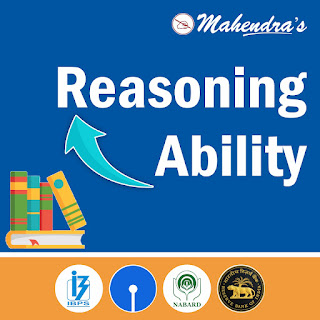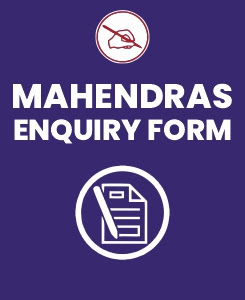Dear Readers,
Mahendras has started special quizzes for IBPS | RBI | SBI | NABARD Exam so that you can practice more and more to crack the examination. IBPS | RBI | SBI | NABARDspecial quiz series will mold your preparations in the right direction and the regular practice of these quizzes will be really very helpful in scoring good marks in the Examination. Here we are providing you the important question of reasoning ability for the IBPS | RBI | SBI | NABARD Exam.
Q.1-5. Study the following information carefully and answer the question given below.
There are some persons sitting in a row facing in the north direction. P sits second from the right end. Q sits third to the right of M. More than three persons sit between P and Q. One person sits between M and R. More than six and less than ten persons sit to the right of M. More than one person sits between Q and R.
निम्नलिखित जानकारी का ध्यानपूर्वक अध्ययन करें और नीचे दिए गए प्रश्न का उत्तर दें।
एक पंक्ति में उत्तर दिशा की ओर उन्मुख होकर कुछ व्यक्ति बैठे हैं। P दायें छोर से दूसरे स्थान पर बैठता है। Q, M के दायीं ओर दूसरे स्थान पर बैठता है। P और Q के मध्य तीन से अधिक व्यक्ति बैठते है। M और R के मध्य एक व्यक्ति बैठता है। M के दायीं ओर छह से अधिक और दस से कम व्यक्ति बैठते है। Q और R के मध्य एक से अधिक व्यक्ति बैठते हैं।
Q.1. If W sits between R and M, then how many persons can sit to the right of W?
यदि R और M के मध्य W बैठता है, तो W के दायीं ओर कितने व्यक्ति बैठ सकते हैं?
(1) 14
(2) 12
(3) 11
(4) 10
(5) None of these
Q.2. If N sits second to the left of P then what is the position of N with respect to Q?
यदि N, P के बायीं ओर दूसरे स्थान पर बैठता है, तो Q के संबंध में N का स्थान क्या है?
(1) Third to the right
(2) Immediate right
(3) Second to the left
(4) Third to the left
(5) None of these
Q.3. How many persons sit between M and P?
M और P के मध्य कितने व्यक्ति बैठते है?
(1) None
(2) Five
(3) Six
(4) Three
(5) More than six
Q.4. How many persons sit between R and Q?
R और Q के मध्य कितने व्यक्ति बैठते है?
(1) 5
(2) 1
(3) 2
(4) 3
(5) 4
Q.5. How many people are there in the row?
पंक्ति में कितने लोग हैं?
(1) 11
(2) 10
(3) 12
(4) 13
(5) 14
Q.6-10. In the following questions, the symbols %, &, @, $ and * are used with the following meaning as illustrated below.
‘5 % 8’ means ‘5 is not smaller than 8’.
‘5 & 8’ means ‘5 is neither smaller than nor equal to 8’.
‘5 @8’ means ‘5 is neither greater than nor equal to 8’.
‘5 $ 8’ means ‘5 is neither greater than nor smaller than 8’.
‘5 * 8’ means ‘5 is not greater than 8’.
Now, in each of the following questions assuming the given statements to be true, find which of the four Conclusions I and II given below them is/are definitely true and give your answer accordingly.
निम्नलिखित प्रश्नों में, %, &, @, $ और * प्रतीकों का प्रयोग निम्नलिखित अर्थों के अनुसार किया जाता है-
‘5 % 8’ का अर्थ‘5, 8 से छोटा नहीं है’।
‘5 & 8’ का अर्थ '5 न तो 8 से छोटा और न ही 8 के बराबर है'।
‘5 @8’ का अर्थ '5 न तो 8 से बड़ा और न ही 8 के बराबर है।'
‘5 $ 8’ का अर्थ '5 न तो 8 से बड़ा और न ही 8 से छोटा है'।
‘5 * 8’ का अर्थ '5, 8 से बड़ा नहीं है'।
अब, निम्नलिखित में से प्रत्येक प्रश्न में, दिए गए कथनों को सही मानते हुए ज्ञात कीजिये, कि नीचे दिए गए दो निष्कर्षों I और II में से कौन-सा निष्कर्ष निश्चित रूप से सत्य है और उसके अनुसार अपना उत्तर दीजिए।
Q.6. Statements:
A&S$O, P*L&O, D$A*F
Conclusions:
I. F%D
II. S&P
कथन:
A&S$O, P*L&O, D$A*F
निष्कर्ष:
I. F%D
II. S&P
(1) Only II is true.
(2) Both I and II are true.
(3) Only I is true.
(4) Either I or II is true.
(5) Neither I nor II is true.
Q.7. Statements:
K&F*J$G&L&O%M@R
Conclusions:
I. J&R
II. G%F
कथन:
K&F*J$G&L&O%M@R
निष्कर्ष:
I. J&R
II. G%F
(1) Only I is true.
(2) Neither I nor II is true.
(3) Both I and II are true.
(4) Either I or II is true.
(5) Only II is true.
Q.8. Statements:
W&T%X@U, O*P@V$W
Conclusions:
I. W&O
II. V&X
कथन:
W&T%X@U, O*P@V$W
निष्कर्ष:
I. W&O
II. V&X
(1) Both I and II are true.
(2) Only I is true.
(3) Either I or II is true.
(4) Neither I nor II is true.
(5) Only II is true.
Q.9. Statements:
Q$K&N%P, R*S@X$Q
Conclusions:
I. R*Q
II. Q&P
कथन:
Q$K&N%P, R*S@X$Q
निष्कर्ष:
I. R*Q
II. Q&P
(1) Only I is true.
(2) Only II is true.
(3) Neither I nor II is true.
(4) Either I or II is true.
(5) Both I and II are true.
Q.10. Statements:
R$T&P, Y@T&E, P&O%C
Conclusions:
I. T&C
II. E@R
कथन:
R$T&P, Y@T&E, P&O%C
निष्कर्ष:
I. T&C
II. E@R
(1) Only I is true.
(2) Only II is true.
(3) Both I and II are true.
(4) Either I or II is true.
(5) Neither I nor II is true.
ANSWER-
Q.1. 4
Q.2. 1
Q.3. 5
Q.4. 5
Q.5. 3
Q.6. 3
Q.7. 5
Q.8. 1
Q.9. 2
Q.10. 3
R$T&P, Y@T&E, P&O%C
Conclusions:
I. T&C
II. E@R
कथन:
R$T&P, Y@T&E, P&O%C
निष्कर्ष:
I. T&C
II. E@R
(1) Only I is true.
(2) Only II is true.
(3) Both I and II are true.
(4) Either I or II is true.
(5) Neither I nor II is true.
ANSWER-
Q.1. 4
Q.2. 1
Q.3. 5
Q.4. 5
Q.5. 3
Q.6. 3
Q.7. 5
Q.8. 1
Q.9. 2
Q.10. 3






0 comments:
Post a Comment
MAHENDRA GURU